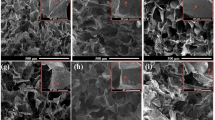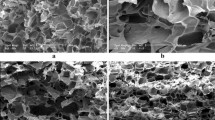Abstract
Chitosan/poly(dl-lactide-co-glycolide) (Ch/dl PLG) composite scaffolds were fabricated by freeze-drying lyophilization, and were evaluated and compared for use as a bone regeneration scaffold through measurements of the compression mechanical properties of the porous scaffolds. Also, In vitro cell culture of Sprague–Dawley rat’s osteoblasts were used to evaluate the phenotype expression of cells in the scaffolds, characterizing the cellular adhesion, proliferation and alkaline phosphatase activity. The gene expression of osteocalcin, sialoprotein, alkaline phosphatase, Type I collagen and TGFβ1 were confirmed in the samples; moreover, it was confirmed, the mineralization by IR spectra and EDS analysis. Our results thus show that Ch/dl PLG scaffolds are suitable for biological applications.







Similar content being viewed by others
References
George J, Kuboki Y, Miyata T. Differentiation of mesenchymal stem cells into osteoblasts on honeycomb collagen scaffolds. Biotechnol Bioeng. 2006;95:404–11.
Du D, Furukawa KS, Ushida T. 3D culture of osteoblast-like cells by unidirectional or oscillatory flow for bone tissue engineering. Biotechnol Bioeng. 2009;102:1670–8.
Wu H, Wan Y, Cao X, Wu Q. Proliferation of chondrocytes on porous poly(dl-lactide)/chitosan scaffolds. Acta Biomater. 2008;4:76–87.
Woo KM, Jun JH, Chen VJ, Seo J, Baek JH, Ryoo HM, et al. Nano-fibrous scaffolding promotes osteoblast differentiation and biomineralization. Biomaterials. 2007;28:335–43.
Orava E, Korventausta J, Rosenberg M, Jokinen M, Rosling A. In vitro degradation of porous poly(dl-lactide-co-glycolide) (PLGA)/bioactive glass composite foams with a polar structure. Polym Degrad Stab. 2007;92:14–23.
Autissier A, Le Visage C, Pouzet C, Chaubet F, Letourneur D. Fabrication of porous polysaccharide-based scaffolds using a combined freeze-drying/cross-linking process. Acta Biomater. 2010;6:3640–8.
Sato T, Chen G, Ushida T, Ishii T, Ochiai T, Tateishi T, Tanaka J. Evaluation of PLLA-collagen hybrid sponge as a scaffold for cartilage tissue engineering. Mater Sci Eng C. 2004;24:365–72.
Oh SH, Kang SG, Kim ES, Cho SH, Lee JH. Fabrication and characterization of hydrophilic poly(lactic-co-glycolic acid)/poly(vinyl alcohol) blend cell scaffolds by melt-molding particulate-leaching method. Biomaterials. 2003;24:4011–21.
Noth U, Rackwitz L, Heymer A, Weber M, Baumann B, Steinert A, Schutze N, Jakob F, Eulert J. Chondrogenic differentiation of human mesenchymal stem cells in collagen type I hydrogels. J Biomed Mater Res A. 2007;83:626–35.
Dai W, Kawazoe N, Lin X, Dong J, Chen G. The influence of structural design of PLGA/collagen hybrid scaffolds in cartilage tissue engineering. Biomaterials. 2010;31:2141–52.
Sakurai K, Maegawa T, Takahashi T. Glass transition temperature of chitosan and miscibility of chitosan/poly(N-vinyl pyrrolidone) blends. Polymer. 2000;41:7051–6.
Nagahama H, Maeda H, Kashiki T, Jayakumar R, Furuike T, Tamura H. Preparation and characterization of novel chitosan/gelatin membranes using chitosan hydrogel. Carbohydr Polym. 2009;76:255–60.
Wan Y, Cao X, Wi Q, Zhang S, Wang S. Preparation and mechanical properties of poly(chitosan-g-dl-lactic acid) fibrous mesh scaffolds. Polym Adv Tech. 2008;19:114–23.
Lee J, Nam S, Im S, Park Y, Lee Y, Seol Y. Enhanced bone formation by controlled growth factor delivery from chitosan based biomaterials. J Control Release. 2002;78:187–97.
Wan Y, Lu X, Dalai S, Zhang J. Thermophysical properties of polycaprolactone/chitosan blend membranes. Thermochim Acta. 2009;487:33–8.
Schliecker G, Schmidt C, Fuchs S, Wombacher R, Kissel T. Hydrolytic degradation of poly(lactide-co-glycolide) films: effect of oligomers on degradation rate and crystallinity. Int J Pharm. 2003;266:39–49.
Liu L, Won Y, Cooke PH, Coffin DR, Fishman ML, Hicks KB, Ma PX. Pectin/poly(lactide-co-glycolide) composite matrices for biomedical applications. Biomaterials. 2004;25:3201–10.
Wan Y, Wu H, Yu A, Dijiang W. Biodegradable polylactide/chitosan blend membranes. Biomacromolecules. 2006;7:1362–72.
Wan Y, Wu Q, Wang S, Zhang S, Hu Z. Mechanical properties of porous polylactide/chitosan blend membranes. Macromol Mater Eng. 2007;292:598–607.
Di Toro R, Betti V, Spampinato S. Biocompatibility and integrin-mediated adhesión of human osteoblasts to poly (dl-lactide-co-glycolide) copolymers. Eur J Pharm Sci. 2004;21:161–9.
Martel-Estrada S, Martínez-Pérez C, Chacón-Nava J, García-Casillas P, Olivas-Armendariz I, Martel-Estrada S, Martínez-Pérez C, Chacón-Nava J, García-Casillas P, Olivas-Armendáriz I. Synthesis and thermophysical properties of chitosan/poly(dl-lactide-co-glycolide) composites prepared by thermally induced phase separation. Carbohydr Polym. 2010;81:775–83.
Anagnostou F, Debet A, Pavon-Djavid G, Goudaby Z, Hélary G, Migonney V. Osteoblast functions on functionalized PMMA-based polymers exhibiting Staphylococcus aureus adhesion inhibition. Biomaterials. 2006;27:3912–9.
Mikus J, Steverding D. A simple colorimetric method to screen drug cytotoxicity against Leishmania using the dye Alamar Blue®. Parasitol Int. 2000;48:265–9.
He L, Liu B, Xipeng G, Xie G, Liao S, Quan D, Cai D, Lu J, Ramakrishna S. Microstructure and properties of nano-fibrous PCL-b-PLLA scaffolds for cartilage tissue engineering. Eur Cell Mater. 2009;18:63–74.
Ciapetti G, Ambrosio L, Savarino L, Granchi D, Cenni E, Baldini N, et al. Osteoblast growth and function in porous poly ε-caprolactone matrices for bone repair: a preliminary study. Biomaterials. 2003;24:3815–24.
Tsigkou O, Jones J, Polak J, Stevens M. Differentiation of fetal osteoblasts and formation of mineralized bone nodules by 45S5 Bioglass® conditioned medium in the absence of osteogenic supplements. Biomaterials. 2009;30:3542–50.
Anagnostou F, Plas C, Nefussi JR, Forest N. Role of beta-GP-derived Pi in mineralization via ecto-alkaline phosphatase in cultured fetal calvaria cells. J Cell Biochem. 1996;62:262–74.
St-Pierre J, Gauthier M, Lefebvre L, Tabrizian M. Three-dimensional growth of differentiating MC3T3-E1 pre-osteoblasts on porous titanium scaffolds. Biomaterials. 2005;26:7319–28.
Gou Z, Chang J. Synthesis and in vitro bioactivity of dicalcium silicate powders. J Eur Ceram Soc. 2004;24:93–9.
Rámila A, Vallet-Regí M. Static and dynamic in vitro study of a sol-gel glass bioactivity. Biomaterials. 2001;22:2301–6.
Altmann B, Steinberg T, Giselbrecht S, Gottwald E, Tomakidi P, Bächle-Haas M, Kohal R. Promotion of osteoblast differentiation in 3D biomaterial micro-chip arrays comprising fibronectin-coated poly (methyl methacrylate) polycarbonate. Biomaterials. 2011;32:8947–56.
Whited B, Whitney J, Hofmann M, Xu Y, Rylander M. Pre-osteoblast infiltration and differentiation in highly porous apatite-coated PLLA electrospun scaffolds. Biomaterials. 2011;32:2294–304.
Acknowledgments
The authors acknowledge the financial support of the Mexican Public Education Secretary (SEP) and the Mexican National Council for Science and Technology (CONACyT) through project SEP-CONACyT 2012-180909 and PROMEP 103.5/10/4995 UACJ-EXB-156. Also, we greatly appreciate the support of Christian Chapa and Monica Duarte during the SEM/EDS, and mechanical characterization. We are extremely grateful for the advice and assistance of Manuel Alejandro Hernández-Aguilar, B.S., Idahí Gutiérrez-Ornelas B.S., and Laura De la Rosa, PhD, during the cell culture.
Conflict of interest declaration
The authors have no conflict of interest to declare.
Author information
Authors and Affiliations
Corresponding author
Rights and permissions
About this article
Cite this article
Martel-Estrada, S.A., Olivas-Armendáriz, I., Martínez-Pérez, C.A. et al. Chitosan/poly(dl,lactide-co-glycolide) scaffolds for tissue engineering. J Mater Sci: Mater Med 23, 2893–2901 (2012). https://doi.org/10.1007/s10856-012-4762-8
Received:
Accepted:
Published:
Issue Date:
DOI: https://doi.org/10.1007/s10856-012-4762-8




